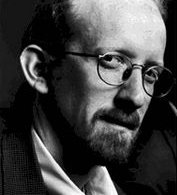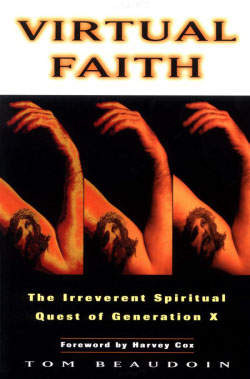I first read Tom Beaudoin’s book, Virtual Faith, in July 1998, while studying in San Francisco, the month after it was published by Jossey-Bass.
 Tom wrote his first book as an expression of three years research at Harvard Divinity School in Cambridge Massachussets. He completed a doctorate at religion and education at Boston College and stayed on teaching in the theology and Religious Education and Pastoral Ministry departments there. Since 2004 he he has been an Associate Professor in the Religious Studies Department at Santa Clara University in California. In 2004 he published his second book, Consuming Faith: Integrating Who We Are With What We Buy.
Tom wrote his first book as an expression of three years research at Harvard Divinity School in Cambridge Massachussets. He completed a doctorate at religion and education at Boston College and stayed on teaching in the theology and Religious Education and Pastoral Ministry departments there. Since 2004 he he has been an Associate Professor in the Religious Studies Department at Santa Clara University in California. In 2004 he published his second book, Consuming Faith: Integrating Who We Are With What We Buy.
In Virtual Faith Tom sets out to provide a theological interpretation of GenX pop culture, exploring what he calls an ‘irreverent spirituality’.
GenX Journey
 Tom’s first chapter is a helpful exploration of pivotal events that shaped him and his peers. Born in 1969, he spent his teenage years in the 1980s; themes of family breakdown, technological advancement and the threat of nuclear war witnessed alongside movies such as Kramer Versus Kramer, Star Wars, The Day After.
Tom’s first chapter is a helpful exploration of pivotal events that shaped him and his peers. Born in 1969, he spent his teenage years in the 1980s; themes of family breakdown, technological advancement and the threat of nuclear war witnessed alongside movies such as Kramer Versus Kramer, Star Wars, The Day After.
As a teenager he became a consumer of popular culture, as expressed in radio, MTV, popular film, television, comic books, cartoons, clothing, fantasy gaming, sports and concerts. Tom played bass guitar in bands, at first playing only ‘Christian’ music, then moving to ‘secular’ music.
As a College (University) student he experimented with the spiritualities connected with a reform synagogue, a moderate Southern Baptist church and a progressive Catholic Church. Beaudoin taught high school for two years before taking up graduate studies in religion.
Tom refers to his time studying theology at Harvard Divinity School, including a course by Harvey Cox, who has written the foreward. What amazes me is that Cox, known for his 1965 book, The Secular City, is still teaching and writing!
Formed by Pop Culture
In his second chapter Beaudoin outlines his thesis that Generation X, born roughly in the 1960s and 1970s, share experiences of popular cultural ‘events’. He is referring to a variety of pop culture phenomena including bodily costuming, music videos, cyberspace, movies, popular songs, television shows, board games, products and trends. He contends that Generation Xers live religiously mostly through the popular culture. In addition he identifies the ways in which his generation share a widespread regard for paganism and mysticism. Religious institutions are spurned as people take the symbols, values and rituals from various religious traditions and combine them into their personal spirituality.
Beaudoin is upfront about his focus on white middle class members of his generation. “My book begs for conversation with studies that explore other groups and cultures within the generation.”
Tom reminds his readers that there is no theology apart from life in the world, from life in culture. “In order to understand our culture, we must think theologically. And in order to comprehend our theology, we must know our culture”. He uses the word “religious” rather than “religion” to avoid the institutional connotations rejected by his peers. The ‘religious’ involves a profound experience of a limitation, a hunger for depth.
Foundational to Tom’s engagement with popular culture is the belief that people (or forms of pop culture) who profess to know little or nothing about the religious may form, inform or transform religious meaning for people of faith. He refers to the Catholic concept of “Sensus Fidelium”, literally the “sense of the faithful.” Just as the Spirit guides the Church’s teachers and leaders, the faithful, as a whole, have an instinct or “sense” about when a teaching is – or is not – in harmony with the true faith. Tom goes one step further with the term “sensus infidelium”.
Tom refers us to Richard Mouw, at Fuller Theological Seminary, who writes that education is not a prerequisite for insight into God. In his book, “Consulting the Faithful: What Christian Intellectuals Can Learn from Popular Religion“, Mouw exposes the snobbishness of theologians who would learn from third world popular culture but who overlook the popular culture in their backyard.
Being Virtually Religious
The third chapter is the one that has stayed with me longest. Beaudoin begins by referring to an article by Katherine Bergeron, “The Virtual Sacred: Finding God at Tower Records“, the cover story of The New Republic, February 27, 1995. (Katherine is Associate Professor of Music at College of Letters and Science at Berkeley University).
 In her article Bergeron explores the dynamics behind the popularity of the Gregorian chant as evidenced in the massive sales of Chant: The The Benedictine Monks of Santo Domingo De Silos
In her article Bergeron explores the dynamics behind the popularity of the Gregorian chant as evidenced in the massive sales of Chant: The The Benedictine Monks of Santo Domingo De Silos. She points out that the recording is a simulation of 19th century chant, itself a simulation of 9th century chant. In her analysis of the spirituality associated with engaging with this ‘timeless music’ she concludes that this vitual religiousness does not demand anything of the listener.
Beaudoin responds to this critique by reminding us that ‘virtual religious experiences’ do demand something of us as they expose the amount of simulation that happens in what we have assumed to be ‘real’ religious experiences. He points to the term ‘religiosity’ which in popular culture has come to refer to affected or fake sort of piety.
Tom finishes this chapter with the four major religious themes he will explore in the rest of the book:
1. Deep suspicion of religious institutions
2. Emphasis on the sacred nature of experience
3. Religious dimension of suffering
4. Exploration of faith and ambiguity
